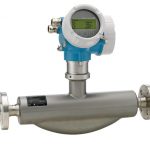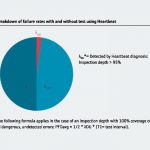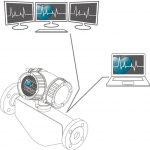In chemical and petrochemical companies, safety has the highest priority. Flowmeters must consequently ensure maximum reliability. Although costly, proof testing is the established method for validating functional reliability. Endress+Hauser’s Heartbeat Technology for all two-wire flowmeters enables correct functioning to be verified continuously with very low failure rates in accordance with IEC 61508 – directly in the pipe.
Author Peter Dietrich Department Manager Flow Marketing, Endress+Hauser
Endress+Hauser’s standardised two-wire concept for flow rate and level incorporates six physical measuring parameters with 24 prod-uct lines for the most diverse instrumentation tasks. Coriolis, electromagnetic, vortex meter and ultrasonic are methods for flow measurement while guided and free-space radar are suitable for level measurement.
A uniform approach to planning, procurement, training, maintenance and operation offers significant potential for savings. Complexity is reduced in all processes and safety simultaneously increased as working with these field devices becomes routine – in the best sense of the word. The benefits of this approach are particularly significant with SIL safety devices.
Safety first
The purpose of safety devices is to reduce the risk associated with plants and processes to a reasonable level. A PCT safety device generally comprises three components: a sensor, an actuator and a safety control. Two standards are of particular importance for the development, manufacture and use of such devices for SIL safety equipment: the basic IEC 61508 standard and IEC 61511 specifically for the process industry. Against this background, the operator has the option of using IEC 61511-compliant “proven-in-use” devices or devices developed in accordance with IEC 61508. Devices to IEC 61508 have the advantage of a development process incorporating a management system which largely prevents systematic errors. This high quality makes it possible to use them in safety devices right from the market launch. Endress+Hauser’s two-wire flow and level devices were consistently developed in accordance with the 2010 revised version of IEC 61508 and are therefore suitable for use in safety systems.
Namur has likewise recognised the advantages of IEC 61508-compliant devices for safety-related applications and documented this in Namur Recommendation NE 130 “Proven-in-use Devices for Safety Instrumented Systems”.
The hardware and software for all devices in the standardised, two-wire design were developed in accordance with SIL 2 and SIL 3 respectively. This means they can be used in SIL 2 safety devices or in SIL 3 devices with homogeneous redundancy. The device series has a hardware and software lock to ensure that no errors occur as a result of unauthorised access. At the same time, a special safety sequence guarantees correctly configured parameters. Systematic errors are therefore avoided when configuring the devices, e. g. the creepage in a flowmeter can no longer be set too high inadvertently.
Plant operators must verify that their safety devices are functioning correctly by means of proof tests at regular intervals. This applies to the entire safety chain. The individual components such as flow or level measuring devices are also typically inspected as part of the proof test.
What is required by the standard?
The requirements for proof tests on SIL safety devices are defined in IEC 61508 or IEC 615011 as well as in the VD VDE 2180 technical rule and Namur Recommendation NE 79. These standards and rules identify two main purposes of proof tests:
- To identify dangerous, undetected errors which could lead to failure of the safety device
- To verify the correct functioning of the safety device at regular intervals
They additionally provide details of the neces-sary proof test intervals, methods and documentation. The test intervals depend on the SIL characteristics, the depth of inspection and other safety parameters such as the demand rate, redundancy and fault tolerance. The VDI/VDE 2180 technical rule, for example, stipulates test intervals of one year as best practice.
It is important to note that all of the applicable standards explicitly allow for flexibility regarding the test intervals. VDI/VDE 2180 states that more flexible intervals are possible, say, in the event of diagnostic coverage and operational experience. Namur NE 79 likewise specifies that the objective must be to extend the testing periods through the use of improved, automatic diagnostic procedures with a greater degree of coverage.
According to current standards for functional safety, it is not only permitted but also desirable as part of proof testing to optimise the test intervals by means of suitable diagnostic functions. The test intervals for complex recalibrations in flowmeters can thus be extended in conformity with the standards.
The solution in practice
The demand for reliable, fast and easy testing is high. Ideally, testing should be of a high quality, very detailed and not necessitate shutting down the system. This is precisely what Endress+Hauser’s Heartbeat Technology for all flowmeters in the two-wire device range offers. Heartbeat Technology guarantees comprehensive, continuous device validation directly in the pipe with no need for disassembly. Thanks to the high overall inspection depth of 95 %, the increase in the average probability of failure (PFDavg) is significantly smaller. The possible operating life is extended as a result. Safety system operators can optimise the nature and scope of their proof tests. Heartbeat Technology is an accepted test method and a genuine alternative to complex procedures such as recalibration or actually triggering operating points in safety instrumented systems.
Heartbeat Technology has been implemented in the devices in the Proline flowmeter range and is available via all operating and system integration interfaces. This includes, for example, Promass 200 Coriolis mass flowmeters in two-wire technology or Prowirl 200 vortex flowmeters.
Heartbeat Technology is a standardised testing concept for flowmeters in two-wire design which increases plant availability and process safety. The main advantages in use are:
- The entire signal chain can be tested while the device is installed without triggering the operating point
- The calibration intervals for proof tests are extended
- No intervention is required in the measuring circuit and there is no need for work in the field or on the device
- Systematic errors are avoided through automated and simple test procedures
- Complete and traceable verification results are available at the push of a button
- Device functions are tested with a total test coverage (TTC) > 95 %
Traceability
All tests with Heartbeat Technology are traced back to a fixed factory state. Their internal references are subject to traceable calibration as part of the manufacturing process. These references are redundantly implemented in the device – in both measuring and testing routines – so that synchronous running can be tested continuously. This allows reliable detection of even the smallest drift or aging in the reference electronics components. Heartbeat Technology ensures that the entire signal chain – from the sensor through the transmitter to the outputs – is tested seamlessly. The technology meets the requirements for traceable testing in accordance with ISO 9001, as confirmed by a TÜV Süd certificate.
An intelligent testing concept also ensures easy functional tests at the push of a button or using integrated test functions in level devices with two-wire technology. The position and amplitude of the sensor signals supplied by the level devices are tested by means of a special sequence integrated in the software. A simulation then verifies the activation of the safety function.
Proof testing of SIL safety devices or tests in the framework of the German Water Resources Act (WHG) can thus be carried out without interrupting the process and without disassembling the device. Continuous self-diagnostics and a development methodology in accordance with IEC 61508 enable the test cycles to be extended by triggering the operating point or removing the level sensors. The advantage for plant owners or operators is maximum safety and a high level of availability.
Hall 11.1, Booth C27
cpp-net.com/0215437
Share:









